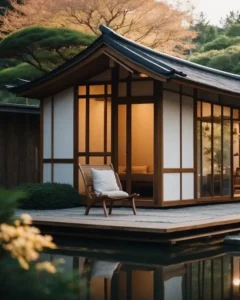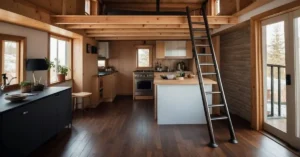If you are here only for the inspirations you can get there directly here!
Concept of Japanese Style Tiny House
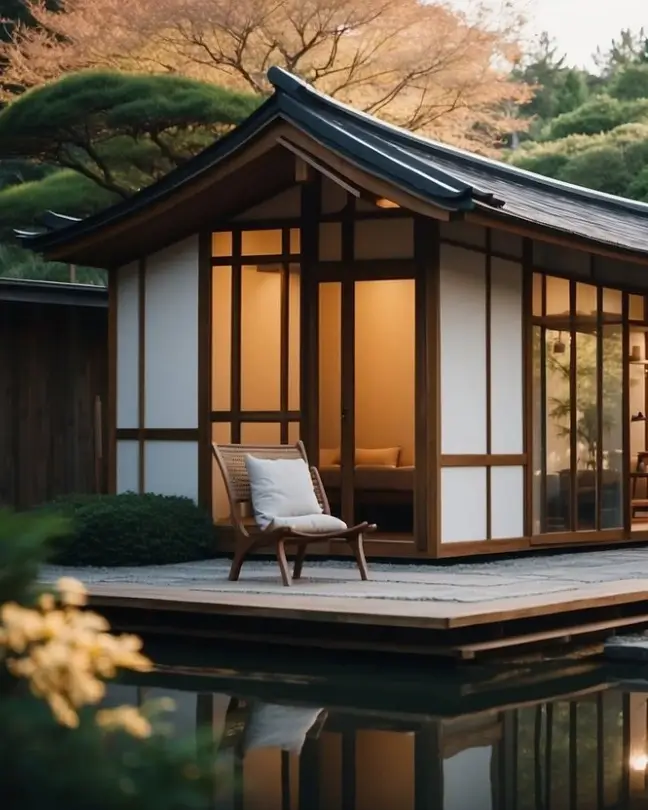
Japanese style tiny houses are a reflection of Japan’s well-known minimalist aesthetic, emphasizing clean lines, functional design, and a connection to nature. These homes are typically characterized by their efficient use of space, often embodying the principle of Wabi-Sabi, which appreciates the beauty in imperfection and transience.
Key Features:
- Size: On average, these houses occupy small footprints, making them a perfect fit for urban environments where space is at a premium.
- Design: Interior layouts are thoughtfully planned to maximize functionality, often featuring multipurpose areas and built-in storage.
- Materials: Use of natural materials such as wood and paper is common, contributing to a warm and organic feel within the space.
These houses frequently incorporate traditional elements like Shoji screens, which allow for privacy while still permitting light to pass through, and Tatami mats, which serve as both flooring and seating.
Natural Elements:
- Light: Careful attention is given to the flow of natural light, embracing the concept of Yūgen, a subtle and profound grace.
- Greenery: Plants and small gardens are integrated into living spaces, blurring the lines between indoors and outdoors.
The popularity of micro homes in Tokyo demonstrates that such spaces can be both liveable and luxurious despite their size. Craftsmanship and attention to detail ensure that each tiny house is not only a place to live but a work of art that reflects the owner’s personal style and the ethos of Japanese minimalism.
Architectural Features
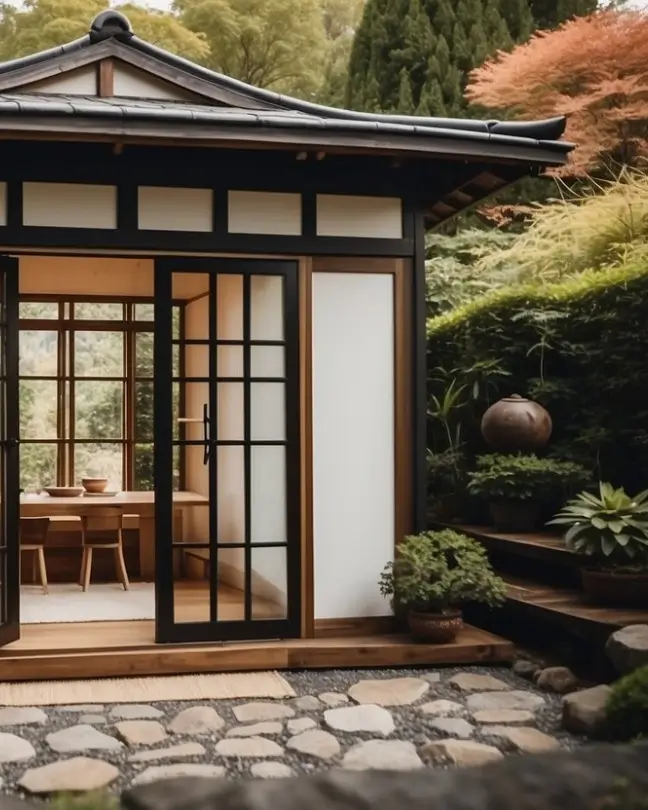
Japanese tiny houses cleverly incorporate traditional elements into small-scale structures, balancing efficient use of space with cultural aesthetics.
Sukiya-Zukuri Influence

Japanese tiny homes often feature the Sukiya-Zukuri style, characterized by a refined and delicate appearance that evokes the principles of tea houses. This includes natural materials and a subtle color palette to establish a tranquil setting.
Shoji Screens and Fusuma Panels

Shoji screens and Fusuma panels are pivotal in these homes, sliding doors made of wooden frames covered in translucent paper allow light to diffuse softly, while also serving as movable walls that can redefine spaces as needed.
Tatami Flooring

They typically utilize Tatami, a type of matting crafted from straw, giving rooms an authentic Japanese touch. Besides contributing to the aesthetic, it offers a measured unit for defining space proportions.
Engawa Verandas

Many homes include an Engawa, an edging strip that acts as an intermediary space between the inside and the garden or street, often used to expand the living area in fine weather.
Asymmetrical Aesthetics
Asymmetry plays a key role, steering clear of predictable patterns. This design strategy ensures each tiny home is a unique reflection of its owner’s preferences while adapting to the intricate constraints of limited space.
Construction Materials
In Japanese tiny houses, the choice of construction materials is both a cultural homage and a practical strategy. They utilize natural materials that are traditionally associated with Japanese architecture, enhancing the homes’ connection to nature and sustainability.
Natural Materials Usage
Japanese tiny house builders often incorporate bamboo and timber due to their natural strength and lightweight properties. These materials are not only abundant in Japan but also offer flexibility in design and a low environmental impact. For insulation and tranquility, rice straw is used in traditional tatami mat flooring, which provides both thermal insulation and a classic aesthetic.
Traditional Japanese Techniques
Tiny homes in Japan benefit from Shou Sugi Ban, a method where wood is charred to preserve it against the elements. Builders also apply joinery techniques passed down through generations, forgoing nails and screws for interlocking pieces of wood. This craftsmanship not only maximizes space but also celebrates the artistry of Japanese construction traditions.
Interior Decoration
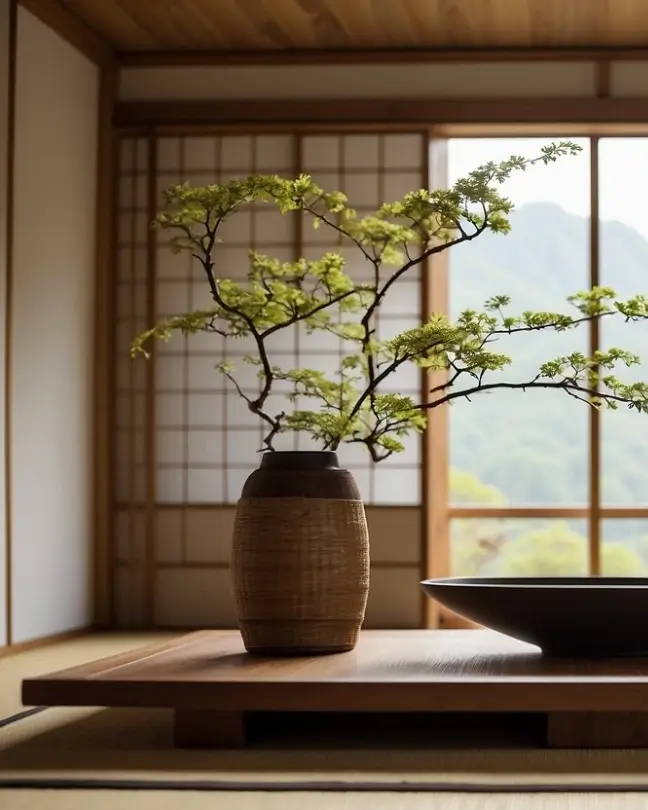
In crafting the interior of a Japanese-inspired tiny house, there are specific elements one must consider to achieve harmony and minimalism. These design strategies are vital to creating a serene space that combines functionality with aesthetic appeal.
Neutral Color Scheme
Choosing a neutral color palette is integral for setting a peaceful and uncluttered backdrop within a tiny house. Whites, creams, and soft greys promote a sense of space and light. The use of these tones helps to reflect natural light more effectively, giving the illusion of a larger area.
Nature-Inspired Accents
Nature is a fundamental aspect of Japanese design. Incorporating nature-inspired elements such as wood, bamboo, or stones can help bring the calmness of the outdoors inside. This can be achieved through wooden furniture, bamboo floor mats, or stone countertops. Such accents provide an organic, relaxing environment that is both beautiful and functional.
Japanese Ornaments
To complete the look, adding a selection of Japanese ornaments can enhance the cultural authenticity. Items such as ikebana (flower arrangements), origami, and traditional Japanese art are more than decorative; they are reflective of the Japanese aesthetic that values simplicity and thoughtful craftsmanship. These ornaments often carry a symbolism that is deeply rooted in Japanese culture.
Cultural Significance
The Japanese-style tiny house movement is deeply rooted in the country’s culture, which emphasizes minimalism, efficiency, and a harmonious connection with nature. Often inspired by traditional Japanese architecture, these homes showcase a practical use of space and foster a simplified lifestyle that is both modern and steeped in tradition.
- Wabi-Sabi: This philosophy is central to Japanese aesthetics, valuing the beauty found in imperfection and transience. Tiny houses often embody the Wabi-Sabi essence, accepting and honoring natural materials and simple forms.
- Kyosho Jutaku: These are micro-homes in Japan, which ingeniously manage to fit into very small urban lots, showcasing the potential of smart design in limited spaces. Tokyo architect Yasuhiro Yamashita is known for these ultra-small dwellings that challenge the traditional notion of a home by focusing on innovative spatial thinking.
Incorporating light and nature into living spaces is another cultural aspect reflected in Japanese tiny homes. Large windows and strategic positioning allow inhabitants to feel a sense of spaciousness and connection to the outside environment, regardless of the home’s compact size.
They employ traditional elements like tatami mats and shoji screens to maximize both functionality and aesthetic appeal without consuming excess space. This approach conveys a sense of zen and reinforces the cultural value of mindfulness and intention in one’s living space.
By adopting such principles, tiny houses are seen not merely as a trend but as an extension of cultural practices that have been evolving over centuries. Thus, the growing interest in Japanese-inspired tiny homes is a testimony to the cultural significance of minimalist and purposeful living.
Inspirations











If you prefer to get inspiration from a video, I recommend this one:
What style is Japanese house?
The Japanese house style is characterized by simplicity, elegance, and a close relationship with nature. Traditional Japanese houses feature elements such as tatami mat flooring, sliding doors, wooden engawa verandas, and a minimalist design that incorporates natural elements.
What are some interesting facts about Japanese houses?
Japanese houses, known as “minka,” are made of wood and feature tatami mat flooring, sliding doors, and engawa verandas. They showcase a unique blend of functionality and tradition, reflecting centuries-old Japanese customs and ingenuity.
What is a typical Japanese house called?
A typical Japanese house is called a “minka,” which translates to “house of the people” in Japanese. These traditional homes are characterized by their unique architectural features, including tatami mat flooring, sliding doors, and wooden engawa verandas.
If you liked this blog article about the topic “Japanese Style Tiny House”, don’t forget to leave us a comment down below to tell us about your experience.
Not enough inspiration yet?
Feel free to also check out our other Articles from the category “Tiny House“ and don’t forget to follow us on Pinterest.

